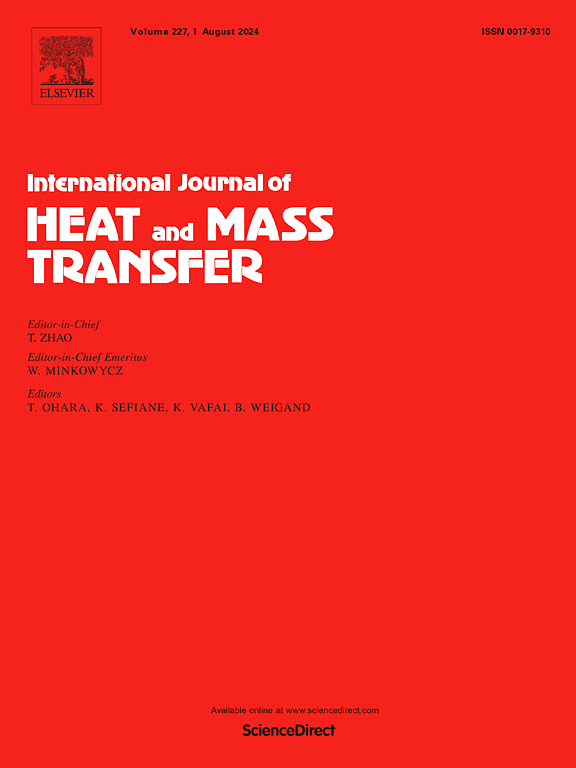Close-contact melting enhancement mechanisms in space-constrained and large-space containers
IF 5.8
2区 工程技术
Q1 ENGINEERING, MECHANICAL
International Journal of Heat and Mass Transfer
Pub Date : 2024-11-13
DOI:10.1016/j.ijheatmasstransfer.2024.126408
引用次数: 0
Abstract
To address the critical challenge of low latent heat storage efficiency, this work explores the performance gains of efficient close-contact melting (CCM) compared to traditional constrained melting (CM) in different containers. A novel CCM model based on the quasi-steady-state method is developed and experimentally validated. The comprehensive performance of CM and CCM in space-constrained containers (SCCs) and large-space containers (LSCs) is compared, and the influence of aspect ratio and heat flux density on the performance differences between the two melting modes is investigated. The study indicates that the performance of CM depends on the competition between conduction attenuation and natural convection enhancement, whereas mixed convection in CCM weakens convective heat transfer, with performance primarily dictated by the heat conduction of the thin molten layer. Based on the ranking of the reduction in melting duration of CCM relative to CM, containers with different spatial structures are ordered as follows: LSC (33.8 %) > vertical SCC (17.3 %) >horizontal SCC (3 %). As the aspect ratio approaches 1, the increase in melting rate and thermal homogeneity of CCM relative to CM becomes more significant. For situations where the aspect ratio deviates from 1, the enhancement gain of CCM over CM is greater in vertical SCCs than in horizontal SCCs. Additionally, increased heat flux density weakens the performance enhancement advantage of CCM over CM, especially in horizontal SCCs.
空间受限容器和大空间容器中的近距离接触熔化增强机制
为了解决潜热存储效率低这一严峻挑战,这项研究探索了在不同容器中高效近接触熔化(CCM)与传统受限熔化(CM)相比的性能增益。基于准稳态方法开发了一种新型 CCM 模型,并进行了实验验证。比较了 CM 和 CCM 在空间受限容器 (SCC) 和大空间容器 (LSC) 中的综合性能,并研究了长宽比和热流密度对两种熔化模式性能差异的影响。研究表明,CM 的性能取决于传导衰减和自然对流增强之间的竞争,而 CCM 中的混合对流削弱了对流传热,其性能主要由薄熔层的热传导决定。根据 CCM 相对于 CM 熔化时间缩短程度的排序,不同空间结构的容器排序如下:LSC (33.8%) > 垂直 SCC (17.3%) > 水平 SCC (3%)。当长宽比接近 1 时,CCM 相对于 CM 的熔化率和热均匀性的增加变得更加显著。在纵横比偏离 1 的情况下,垂直 SCC 中 CCM 相对于 CM 的增强增益大于水平 SCC。此外,热通量密度的增加会削弱 CCM 相对于 CM 的性能提升优势,尤其是在水平 SCC 中。
本文章由计算机程序翻译,如有差异,请以英文原文为准。
求助全文
约1分钟内获得全文
求助全文
来源期刊
CiteScore
10.30
自引率
13.50%
发文量
1319
审稿时长
41 days
期刊介绍:
International Journal of Heat and Mass Transfer is the vehicle for the exchange of basic ideas in heat and mass transfer between research workers and engineers throughout the world. It focuses on both analytical and experimental research, with an emphasis on contributions which increase the basic understanding of transfer processes and their application to engineering problems.
Topics include:
-New methods of measuring and/or correlating transport-property data
-Energy engineering
-Environmental applications of heat and/or mass transfer

 求助内容:
求助内容: 应助结果提醒方式:
应助结果提醒方式:


